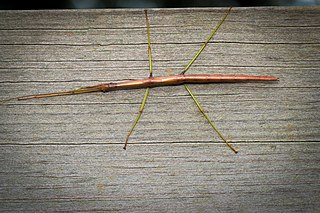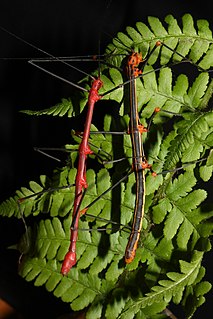
The Phasmatodea are an order of insects whose members are variously known as stick insects, stick-bugs, walking sticks, or bug sticks. They are generally referred to as phasmatodeans, phasmids, or ghost insects. Phasmids in the family Phylliidae are called leaf insects, leaf-bugs, walking leaves, or bug leaves. The group's name is derived from the Ancient Greek φάσμα phasma, meaning an apparition or phantom, referring to their resemblance to vegetation while in fact being animals. Their natural camouflage makes them difficult for predators to detect; still, many species have one of several secondary lines of defence in the form of startle displays, spines or toxic secretions. Stick insects from the genera Phryganistria, Ctenomorpha, and Phobaeticus includes the world's longest insects.

The common walkingstick or northern walkingstick is a species of phasmid or stick insect found across North America. The average length of this species is 75mm (3 in) for males and 95mm (3.7 in) for females.

Diapheromera covilleae, the creosote bush walkingstick, is a species of stick insect in the family Diapheromeridae. They are about 5 to 10 centimetres long depending on the sex, with large tarsal hooks at the end of each leg for superior grip to branches or other objects. They have small eyes and horn-like spines on the head and anus. Since they do not have wings, they travel by walking along branches of trees and bushes, sometimes walking along the ground in search for the next perch or food source. Females are usually 3 to 4 centimetres longer than males and have a larger body. Females are also grey in color while males are more brown.

Diapheromerinae is a subfamily of the stick insect family Diapheromeridae. They belong to the superfamily Anareolatae of suborder Verophasmatodea.

Diapheromera arizonensis, the Arizona walkingstick, is a species of walkingstick in the family Diapheromeridae. It is found in North America.

Diapheromera is a genus of stick insects in the family Diapheromeridae. There are about 14 described species in Diapheromera.
Diapheromera persimilis, the similar walkingstick, is a species of walkingstick in the family Diapheromeridae. It is found in North America.

Megaphasma is a genus of walkingsticks in the family Diapheromeridae. There are at least two described species in Megaphasma.

Diapheromera velii, the prairie walkingstick, is a species of walkingstick in the family Diapheromeridae. It is found in North America.
Manomera tenuescens, the slender-bodied walkingstick, is a species of walkingstick in the family Diapheromeridae. It is found in North America.

Pseudosermyle is a genus of walkingsticks in the family Diapheromeridae. There are more than 20 described species in Pseudosermyle.
Timema nevadense, the Nevada timema, is a species of walkingstick in the family Timematidae. It is found in North America.
Manomera blatchleyi, the blatchley walkingstick, is a species of walkingstick in the family Diapheromeridae. It is found in North America.

Timema genevievae, or Genevieve's timema, is a species of walkingstick in the family Timematidae. It is found in North America.
Parabacillus coloradus, the Colorado short-horn walkingstick, is a species of walkingstick in the family Heteronemiidae. It is found in North America.
Timema boharti, or Bohart's timema, is a species of walkingstick in the family Timematidae. It is found in North America.
Timema podura, the Sierra Nevada timema, is a species of walkingstick in the family Timematidae. It is found in North America.

Timema chumash, the chumash timema, is a species of walkingstick in the family Timematidae. It is found in North America.
Pseudosermyle catalinae, the Catalina walkingstick, is a species of walkingstick in the family Diapheromeridae. It is found in North America.
The 2019 Cherokee Nation of Oklahoma principal chief election was held on Saturday, June 1, 2019. Former Cherokee Nation Secretary of State Chuck Hoskin, Jr. defeated Tribal Councilman Dick Lay in the election.








